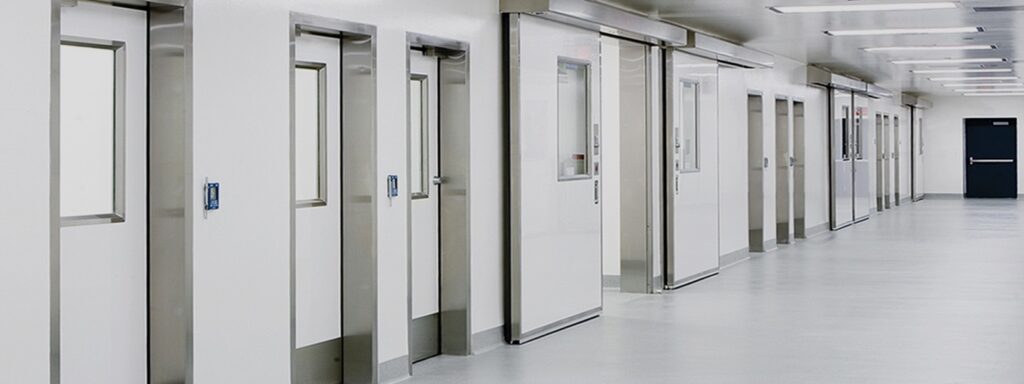
Pharmaceutical facilities are among the most highly regulated environments in the world. Every aspect, from equipment to infrastructure, must comply with strict hygiene, safety, and quality standards. Among the essential components that ensure these standards are maintained are Pharmaceutical Doors.
Unlike conventional doors, pharmaceutical-grade doors are designed to meet specialized requirements such as air-tightness, easy cleanability, resistance to chemicals, and compliance with industry standards like GMP (Good Manufacturing Practices). This blog will give you a detailed understanding of the key features of Pharmaceutical Doors, the standards they must adhere to, and how to select the right Pharmaceutical Door Suppliers and Manufacturers for your facility.
Why Pharmaceutical Doors Are Crucial in the Industry
Pharmaceutical facilities must maintain controlled environments where even the smallest lapse in hygiene can compromise product safety. A Pharmaceutical Door is not just an entry point—it acts as a barrier to contamination, supports controlled airflow, and contributes to overall compliance.
Some reasons why they are critical include:
-
Contamination Control: Prevents dust, microbes, and particulate matter from entering cleanroom areas.
-
Air Pressure Management: Ensures differential pressure between rooms is maintained to avoid cross-contamination.
-
Durability: Designed to withstand frequent cleaning, chemical exposure, and high-traffic use.
-
Compliance: Supports adherence to GMP, FDA, and ISO cleanroom requirements.
Key Features of Pharmaceutical Doors
When selecting a Pharmaceutical Door Manufacturer or evaluating options from Pharmaceutical Door Suppliers, it’s essential to understand the critical features these doors should offer.
1. Hygienic Design
Pharmaceutical doors are built with smooth, flush surfaces that are free from cavities or gaps where dust and microbes could accumulate. Materials like stainless steel, HPL (High Pressure Laminate), and powder-coated steel are commonly used.
2. Air-Tight Sealing
High-quality Pharmaceutical Doors provide airtight sealing to maintain cleanroom integrity. This ensures pressure differentials between sterile and non-sterile areas remain stable.
3. Resistance to Chemicals
Since cleaning in pharmaceutical facilities involves aggressive chemicals and disinfectants, these doors are manufactured using corrosion-resistant materials.
4. Flush-Mounted Vision Panels
For visibility without compromising cleanliness, many pharmaceutical doors feature flush-mounted, shatterproof glass panels that are easy to sanitize.
5. Smooth Operation
They are engineered for frequent use, with high-quality hinges and automatic closing systems to ensure seamless operation.
6. Fire Resistance (Optional)
In some facilities, Pharmaceutical Doors are also required to be fire-rated to add an extra layer of safety.
Industry Standards for Pharmaceutical Doors
To ensure compliance and safety, Pharmaceutical Door Manufacturers design doors based on global industry standards. Some of the most important include:
Good Manufacturing Practices (GMP)
Pharmaceutical doors must comply with GMP guidelines, which mandate surfaces that are smooth, easy to clean, and resistant to microbial growth.
ISO Cleanroom Standards
ISO 14644 outlines cleanroom classifications. Doors used in these facilities must not compromise airflow or particle control.
FDA Guidelines
The U.S. Food and Drug Administration requires pharmaceutical facilities to use doors that support contamination-free production environments.
Fire & Safety Standards
Depending on the region, Pharmaceutical Door Suppliers must ensure products comply with local fire resistance and safety norms.
Types of Pharmaceutical Doors
Not all pharmaceutical doors are the same. The type you choose depends on your facility’s specific requirements.
-
Swing Doors – Most common, easy to use, and suitable for corridors and entry points.
-
Sliding Doors – Save space and often used in cleanroom areas.
-
Hermetically Sealed Doors – Provide maximum airtight sealing, suitable for sterile environments.
-
Fire-Rated Doors – Designed for areas where fire safety regulations apply.
-
Automatic Doors – Enhance hygiene by reducing physical contact.
Choosing the Right Pharmaceutical Door Manufacturer
When investing in pharmaceutical doors, it’s important to partner with the right Pharmaceutical Door Manufacturer who can deliver quality and compliance. Here are key factors to consider:
-
Experience: Choose a manufacturer with proven expertise in the pharmaceutical sector.
-
Certifications: Look for ISO-certified or GMP-compliant suppliers.
-
Customization: Ensure they can provide doors tailored to your cleanroom design.
-
Material Quality: Verify the materials used are durable and resistant to cleaning agents.
-
After-Sales Service: Maintenance and service support are crucial for long-term use.
How to Select Reliable Pharmaceutical Door Suppliers
Reliable Pharmaceutical Door Suppliers not only deliver products but also provide guidance, installation, and after-sales service. Here’s what to look for:
-
Product Range: A good supplier offers multiple door types for different facility needs.
-
Delivery Timelines: Ensure they can supply doors within your project deadlines.
-
Compliance Knowledge: Suppliers should be well-versed in industry regulations.
-
Client References: Past projects in the pharmaceutical industry indicate reliability.
Common Applications of Pharmaceutical Doors
Pharmaceutical doors are widely used across multiple controlled environments, including:
-
Cleanrooms – For maintaining sterile conditions.
-
Laboratories – Where chemical resistance and hygiene are critical.
-
Manufacturing Areas – To maintain process integrity.
-
Hospitals & Healthcare Facilities – In operation theatres, ICUs, and isolation wards.
-
Research Facilities – For contamination-free research and testing environments.
Benefits of Using Pharmaceutical-Grade Doors
Installing the right Pharmaceutical Door brings several benefits to a facility:
-
Maintains sterility and cleanliness.
-
Enhances energy efficiency by preventing air leaks.
-
Supports regulatory compliance.
-
Improves safety with fire-rated options.
-
Provides durability against frequent cleaning and disinfection.
Conclusion
A Pharmaceutical Doors is far more than just a physical barrier—it is a vital element of contamination control, safety, and compliance in pharmaceutical and healthcare environments. Choosing the right Pharmaceutical Door Supplier or Manufacturer ensures your facility meets regulatory requirements while maintaining efficiency and safety.
Whether you need hermetically sealed doors for cleanrooms, fire-rated options for safety, or automatic models for modern facilities, investing in high-quality pharmaceutical doors is a decision that safeguards both your processes and your people.

